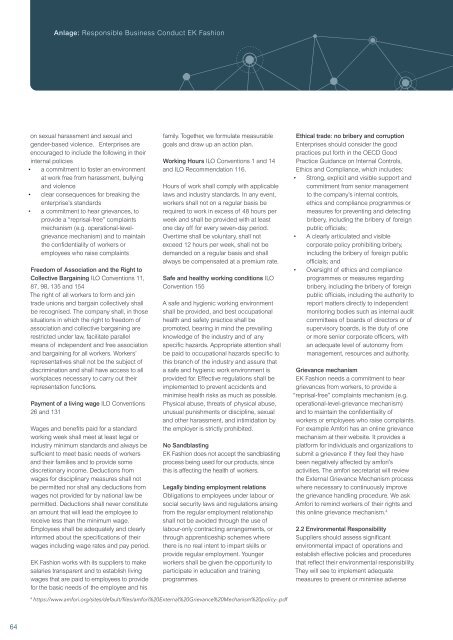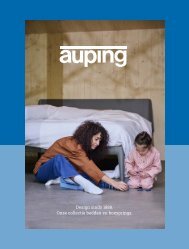EK Fashion ESG-Jahresbericht 2021
EK Fashion ESG-Jahresbericht 2021
EK Fashion ESG-Jahresbericht 2021
Erfolgreiche ePaper selbst erstellen
Machen Sie aus Ihren PDF Publikationen ein blätterbares Flipbook mit unserer einzigartigen Google optimierten e-Paper Software.
Anlage: Responsible Business Conduct <strong>EK</strong> <strong>Fashion</strong><br />
on sexual harassment and sexual and<br />
gender-based violence. Enterprises are<br />
encouraged to include the following in their<br />
internal policies<br />
• a commitment to foster an environment<br />
at work free from harassment, bullying<br />
and violence<br />
• clear consequences for breaking the<br />
enterprise’s standards<br />
• a commitment to hear grievances, to<br />
provide a “reprisal-free” complaints<br />
mechanism (e.g. operational-levelgrievance<br />
mechanism) and to maintain<br />
the confidentiality of workers or<br />
employees who raise complaints<br />
Freedom of Association and the Right to<br />
Collective Bargaining ILO Conventions 11,<br />
87, 98, 135 and 154<br />
The right of all workers to form and join<br />
trade unions and bargain collectively shall<br />
be recognised. The company shall, in those<br />
situations in which the right to freedom of<br />
association and collective bargaining are<br />
restricted under law, facilitate parallel<br />
means of independent and free association<br />
and bargaining for all workers. Workers’<br />
representatives shall not be the subject of<br />
discrimination and shall have access to all<br />
workplaces necessary to carry out their<br />
representation functions.<br />
Payment of a living wage ILO Conventions<br />
26 and 131<br />
Wages and benefits paid for a standard<br />
working week shall meet at least legal or<br />
industry minimum standards and always be<br />
sufficient to meet basic needs of workers<br />
and their families and to provide some<br />
discretionary income. Deductions from<br />
wages for disciplinary measures shall not<br />
be permitted nor shall any deductions from<br />
wages not provided for by national law be<br />
permitted. Deductions shall never constitute<br />
an amount that will lead the employee to<br />
receive less than the minimum wage.<br />
Employees shall be adequately and clearly<br />
informed about the specifications of their<br />
wages including wage rates and pay period.<br />
<strong>EK</strong> <strong>Fashion</strong> works with its suppliers to make<br />
salaries transparent and to establish living<br />
wages that are paid to employees to provide<br />
for the basic needs of the employee and his<br />
family. Together, we formulate measurable<br />
goals and draw up an action plan.<br />
Working Hours ILO Conventions 1 and 14<br />
and ILO Recommendation 116.<br />
Hours of work shall comply with applicable<br />
laws and industry standards. In any event,<br />
workers shall not on a regular basis be<br />
required to work in excess of 48 hours per<br />
week and shall be provided with at least<br />
one day off for every seven-day period.<br />
Overtime shall be voluntary, shall not<br />
exceed 12 hours per week, shall not be<br />
demanded on a regular basis and shall<br />
always be compensated at a premium rate.<br />
Safe and healthy working conditions ILO<br />
Convention 155<br />
A safe and hygienic working environment<br />
shall be provided, and best occupational<br />
health and safety practice shall be<br />
promoted, bearing in mind the prevailing<br />
knowledge of the industry and of any<br />
specific hazards. Appropriate attention shall<br />
be paid to occupational hazards specific to<br />
this branch of the industry and assure that<br />
a safe and hygienic work environment is<br />
provided for. Effective regulations shall be<br />
implemented to prevent accidents and<br />
minimise health risks as much as possible.<br />
Physical abuse, threats of physical abuse,<br />
unusual punishments or discipline, sexual<br />
and other harassment, and intimidation by<br />
the employer is strictly prohibited.<br />
No Sandblasting<br />
<strong>EK</strong> <strong>Fashion</strong> does not accept the sandblasting<br />
process being used for our products, since<br />
this is affecting the health of workers.<br />
Legally binding employment relations<br />
Obligations to employees under labour or<br />
social security laws and regulations arising<br />
from the regular employment relationship<br />
shall not be avoided through the use of<br />
labour-only contracting arrangements, or<br />
through apprenticeship schemes where<br />
there is no real intent to impart skills or<br />
provide regular employment. Younger<br />
workers shall be given the opportunity to<br />
participate in education and training<br />
programmes.<br />
Ethical trade: no bribery and corruption<br />
Enterprises should consider the good<br />
practices put forth in the OECD Good<br />
Practice Guidance on Internal Controls,<br />
Ethics and Compliance, which includes:<br />
• Strong, explicit and visible support and<br />
commitment from senior management<br />
to the company’s internal controls,<br />
ethics and compliance programmes or<br />
measures for preventing and detecting<br />
bribery, including the bribery of foreign<br />
public officials;<br />
• A clearly articulated and visible<br />
corporate policy prohibiting bribery,<br />
including the bribery of foreign public<br />
officials; and<br />
• Oversight of ethics and compliance<br />
programmes or measures regarding<br />
bribery, including the bribery of foreign<br />
public officials, including the authority to<br />
report matters directly to independent<br />
monitoring bodies such as internal audit<br />
committees of boards of directors or of<br />
supervisory boards, is the duty of one<br />
or more senior corporate officers, with<br />
an adequate level of autonomy from<br />
management, resources and authority.<br />
Grievance mechanism<br />
<strong>EK</strong> <strong>Fashion</strong> needs a commitment to hear<br />
grievances from workers, to provide a<br />
“reprisal-free” complaints mechanism (e.g.<br />
operational-level-grievance mechanism)<br />
and to maintain the confidentiality of<br />
workers or employees who raise complaints.<br />
For example Amfori has an online grievance<br />
mechanism at their website. It provides a<br />
platform for individuals and organizations to<br />
submit a grievance if they feel they have<br />
been negatively affected by amfori’s<br />
activities. The amfori secretariat will review<br />
the External Grievance Mechanism process<br />
where necessary to continuously improve<br />
the grievance handling procedure. We ask<br />
Amfori to remind workers of their rights and<br />
this online grievance mechanism. 4<br />
2.2 Environmental Responsibility<br />
Suppliers should assess significant<br />
environmental impact of operations and<br />
establish effective policies and procedures<br />
that reflect their environmental responsibility.<br />
They will see to implement adequate<br />
measures to prevent or minimise adverse<br />
effects on the community, natural resources<br />
and the overall environment.<br />
<strong>EK</strong> <strong>Fashion</strong> asks suppliers to have<br />
procedures and standards for the use of<br />
water and energy, handling and disposure<br />
of chemicals and other dangerous<br />
materials, waste management, emissions<br />
and effluent treatment. The procedures and<br />
standards must meet at least the minimum<br />
legal requirements.<br />
No use of energy of non-renewable<br />
sources and minimizing Green house Gas<br />
(GHG) emissions<br />
Suppliers shall keep records of the current<br />
energy sources and emissions and reduce<br />
the use of energy of non-renewable<br />
sources. Targets will be set to work with<br />
green energy sources and thus reduce<br />
emissions to air.<br />
The consumption of energy of nonrenewable<br />
origin is one of the main causes<br />
of greenhouse gas emissions. The<br />
production of textile and garments is an<br />
energy intensive process. Measuring GHG<br />
emissions is a critical first step to reducing<br />
the carbon footprint of an enterprise’s<br />
activities. It helps an enterprise to assess its<br />
impact on the climate and to design<br />
cost-effective emission reduction plans.<br />
• Establish an energy management plan<br />
at the site-level that includes companywide<br />
coordinated measures for energy<br />
management. We ask our suppliers to<br />
measure, report and minimize their<br />
energy consumption and GHG<br />
wherever possible.<br />
• Also, we do encourage our suppliers to<br />
make use of renewable energy sources<br />
like wind- and solar energy. We ask our<br />
supplier to research and use<br />
technologies which use less energy, like<br />
LED lightning.<br />
• Implement best available techniques<br />
(BAT) as defined by Best Available<br />
Techniques Reference Documents for<br />
the sector or sub-sector 3 5 .<br />
Implement energy efficiency measures (e.g.<br />
energy conservation technology,<br />
optimization of steam generation and<br />
pressurized air, waste heat recovery<br />
from waste water and waste gas,<br />
process optimization, etc.)<br />
• Implement energy conservation<br />
measures (e.g. implementation of<br />
energy saving through improvements in<br />
the process and reaction conditions)<br />
• Increase efficiencies and quality so as<br />
to reduce need for re-processing due<br />
to failures<br />
• Install and operate accurate meters<br />
and/or measuring software as a<br />
fundamental step to benchmarking<br />
performance and to initiating efficiency<br />
improvement<br />
Limitations to water use and clean waste<br />
water<br />
The supplier shall measure water use and<br />
determine whether it can source from water<br />
stressed areas responsibly – for example,<br />
by promoting water efficiency and/or<br />
reducing process dependence on fresh<br />
water amongst its suppliers. Waste water<br />
must be treated and tested before releasing<br />
to the environment. The supplier shall<br />
comply to national waste water legislation.<br />
Throughout the production of textiles, a lot<br />
of water is used. In general, most water is<br />
used for cotton cultivation (2/3 or more of<br />
the total volume). Textile processing uses<br />
far less water but causes most water<br />
pollution. This puts great pressure on the<br />
availability and the quality of water in areas<br />
where cultivation and processing take<br />
place. Water use, the source and waste<br />
water in the wet processing also deserves<br />
serious attention, because of the local<br />
pollution impact.<br />
• We ask our suppliers to deliver a<br />
(waste) water policy, testing procedure<br />
and/or a copy of one of the standards.<br />
We ask our suppliers to provide, (LCA)<br />
data on water, energy and chemicals<br />
and emissions. Use the ZDHC (Waste<br />
Water) guidelines and the Unido water<br />
calculator: https://watercalculator.dnvgl.<br />
com/Home/Form.<br />
• We want to be informed about the water<br />
source (rain, groundwater, lake, etc)<br />
• We would like to offer suppliers more<br />
information on a cleaner production<br />
process through the ZDHC, OECD<br />
guidance or MODINT Factsheets which<br />
we could provide to you.<br />
No hazardous Chemicals<br />
No hazardous chemicals shall be used in<br />
processing stage and released in water or<br />
air. Employees shall be protected and<br />
equipped with the right safety measures<br />
and appropriate training. Chemicals shall<br />
be stored and labeled accurately.<br />
Chemicals are used everywhere in the<br />
production of goods. Apart from the<br />
pesticides and fertilizers in the natural fiber<br />
production, the ‘big’ issue, mainly in the<br />
textile chain, is the use of chemicals in<br />
bleaching, dyeing, printing and finishing<br />
and how it effects workers, water and air<br />
effluents.<br />
• Design phase: The base of the use of<br />
chemicals use lies in the design choices.<br />
We ask our business partners to inform<br />
us if any design decision leads to the<br />
use of hazardous chemicals.<br />
• Manage and report production phase:<br />
From there it is important for our<br />
company to know which specific<br />
chemicals are used (chemical<br />
inventory) and how they are used in the<br />
processing. The use of harmful chemicals<br />
during these stages of production<br />
could be harmful for the environment<br />
and the workers and may leave traces<br />
in the final product and thus appear to<br />
the consumer.<br />
• Make a Chemical Risk assessment: An<br />
environmental or human health risk<br />
assessment includes hazard<br />
identification, hazard characterization,<br />
exposure assessment and risk<br />
characterization.<br />
The first two steps are regarded as the<br />
process of hazard assessment. The<br />
methodology of the environmental risk<br />
assessment should align with OECD<br />
guidance. See OECD Environmental<br />
Risk Assessment Toolkit 6 .<br />
The methodology of the health risk<br />
assessment should align with the World<br />
Health Organization guidance. See<br />
International Programme on Chemical<br />
Safety, WHO Human Health Risk<br />
Assessment Toolkit: Chemical Hazards 7 .<br />
Health risks are also addressed in Module 5,<br />
Occupational Health and Safety.<br />
4<br />
https://www.amfori.org/sites/default/files/amfori%20External%20Grievance%20Mechanism%20policy-.pdf<br />
5<br />
https://eippcb.jrc.ec.europa.eu/reference/<br />
64 65


















